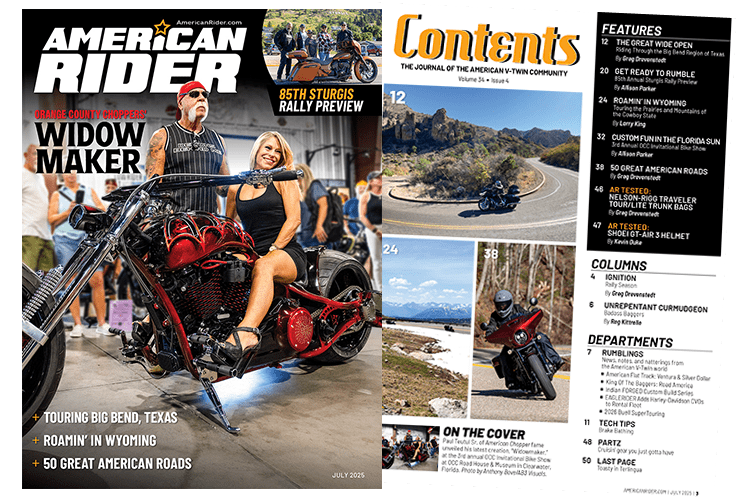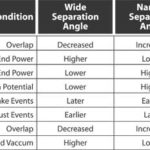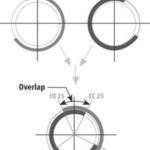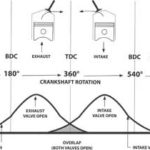OK, we talked about what passes for fuel these days and how even though the octane may stay up, the energy ain’t liable to. Boils down to the evil necessity known as pollution control.
Clever and attentive types might also have noticed a somewhat subtle allusion to the stats on recommended fuel for Evos versus Twinkies. One might well ask, at this juncture, exactly how it is that with fundamentally similar compression ratios, combustion chamber efficiencies, and with bore sizes nowhere near as different as, say, an 883 vs. a 1200 Sportster, the need for more octane prevails in the Twinkie engines?
Most likely, you’ve seen this kind of chart before. It shows the basic shapes, parts and functions of typical camshafts. Though not really a factor on Twin Cam cams, the notion of advancing or retarding the overall timing of a given cam to move the powerband up or down the RPM scale is valid.
Each lobe has only one function, moving as it dos at half engine speed. That said,those functions usually happen in concert with the funtions of the otehr loe. New 96″ Twin Cams do not enjoy that functional “enhancement” however! Since the specs for the stock graind are: intake opens at -3.5 degrees and closes at 40, both events occurring ATDC, with a moderate 216 degrees of duration. Exhaust timing is 41/-1.5 with 220 degrees of duration. What you need to grasp here is that even with what looks to be a reasonable 474 lift on the lobe, actual valve lift is 0.087 TDC on the intake and 0.110 TDC on the exhaust—an elephant with emphysema, panting quick and shallow through a soda straw! With absolutely no overlap for scavenging, the average Briggs & Stratton lawn mover motor breathes deeper than stock Twinkie engines!
Something a bit more normal (in terms of “normally aspirated”) looks like this. Overall cam profiles/grinds incorporating both duration and overlap into the timing to get the best out of an engine, are more important than plain old lift numbers, since those can be deceiving. The TDC lift at the valve is a better gauge than lobe height. For instance, an S&S 510 cam with only 0.0036 inches more lobe height than the stocker, specs at 0.187 and 0.178 (respectively) TDC valve lift. That’s over twice as much as the stock intake and an increase of almost 40 percent on the exhaust side!.
You can overdo overlap. Section one is typical of machines used for towing (and apparently for Harleys) where it’s all about bottom-end grunt, two is for “regular” street use, three is about right for street performance, four is for street/strip yet a little hard to live with on the street, five is for racing where almost all the action is over half throttle, and six is pro race—a.k.a. WFO 24/7!
Perhaps the last trick we need to understand (this time around) is how Lobe Separation Angle (LSA) affects things—which is a lot! The respective lobe centerlines are easy to figure and LSA amounts to the two figures added together then divided by two. (Meaning, the 112 degrees indicated in the diagram is really more like 113.) But it’s really how LSA and overlap interact that tells you why two supposedly similar cams can act so differently in the engine. Widening the LSA reduces the overlap and tightening it increases overlap.
That’s where lift, timing, ramp shapes and more come into play—as you can see here. These two cams’ LSAs “spec” alike but the one on the left will behave itself, whereas the one on the right will come on hard (because of all that overlap), feeling… well… damn cammy! These two have the same LSA but if they were different, the one with a wide LSA will typically be the torquer and the one with a narrower LSA gives quite a bit better top-end power.
It all works pretty much the way this chart implies. Changing lobe centerlines without changing duration can increase or decrease the point at which those important intake events take place. In effect, spreading the LSA is a way of cutting the overlap while still retaining the duration. An increase from, say, 104 to 106 degrees, is considered “retarding” those events so they take place later in the engine’s cycle, reducing cylinder pressure and low-speed performance. Then, of course, there’s vice versa! (Which is sorta where we came in.)
Seems to me, what with all this preoccupation with big-inch drop-on kits, pipes and air cleaners (comprising the bulk of that which is vacuously referred to as “Stage One”) we have overlooked a little something. Something that might go a long ways towards explaining the way EFI H-D engines “see” fuel/air mixtures these days.
Hopefully, long-term readers of this column and any other tech tarts out there know that compression ratios and compression pressure can be two very different things. The former, found mostly in the brochures and propaganda, is a relationship measurement expressed mathematically. The second, found by using a tool on the bowels of your bike, is a reality check in pounds per square inch. Both the tool and the tush-dyno know pretty damn well when there’s enough—usually 180 psi, give or take, is optimal for street hogs. Aside from nasty little surprises like leaky valves or piston rings, there are several things that can affect actual, so-called “dynamic” compression pressures, even beyond the information that a compression tester reveals. Some of the more obvious would be thin head gaskets, milled heads, domed pistons and so on. Another is exhaust (some other day) and lastly (our topic this time) the camshaft(s).
The trouble with Twinkies
We all babble like we have a clue about cam specs! Lift, timing, yadda, yadda! Yet, it seems most of us couldn’t even name the grind number, let alone pertinent info, on cams in our own motors. Worse, we fundamentally ignore some of the more important bits of information regarding our bumpsticks, preferring to play outside the engine with bits and pieces that might offer relief but can’t cure the basic disease. Some might say it’s a touch of asthma for the sake of clean air, but I’m tellin’ ya the sickest part of new H-D engines can only be accurately described as nearly terminal emphysema!
With that notion in mind, it might interest you to know that all 96″ TCs sport stock camshafts with—wait for it—negative overlap! Even the older (’99–’06) 88″ engines only offered about 2 degrees (at least it’s positive) on carbureted bikes and a mere three on EFI machines. So, even though it might not register on your radar as sexy—like loud pipes—a major player on any hopped-up Twinkie has got to be a cam swap. All the fancy pipes and air cleaners and downloads on the planet can’t realize the full potential in these engines without an increase in overlap. Of course, it’s not all that simple to find the best cam choice for your motor’s package of goodies. Not to say that overlap alone is the big deal for good cams—far from it. The harsh reality is that aside from overlap, the factory cam “spec” isn’t all that bad—the two most obvious criteria, lift and intake closing, are about what you’d like with stock heads. But as usual, the big picture is not quite that tidy. So, let’s review some basics about cams, then pay more serious attention to the most overlooked of those, shall we?
First and foremost, we have those four strokes (longer on 96″ engines) to consider. The camshaft that opens and closes the valves in each head makes one complete 360-degree revolution while the crankshaft moves the piston up and down the cylinder twice (720 degrees). Camshaft timing is usually talked about in crankshaft degrees relative to piston placement in the cylinder. We know that the piston is at the top (Top Dead Center) of the cylinder twice and at the bottom (Bottom Dead Center) twice.
The first stroke
Starting at the TDC position, the piston starts moving down the cylinder (intake stroke), picks up speed, and (catch this!) must slow down when it reaches the bottom. As the piston is moving down the cylinder the intake valve is opening. Some air and gas mixture is beginning to flow into the cylinder but the greatest gulp comes when the pressure differential is the greatest. That occurs when the piston reaches maximum velocity. (Velocity=rate of change of position in relation to time.) The things that govern piston velocity are the stroke, rod length and piston pin offset. (In case you’re wondering why it’s important to look at piston velocity during the intake stroke, meet:
Fact One: Volumetric efficiency is directly related to piston velocity, because even at sea level we only have 14.7 psi to fill the cylinders.
Stroke two—ain’t for two-strokes
As the piston reaches BDC the intake valve is almost closed. The intake valve finally closes after BDC when the piston makes its way back up the cylinder. As the piston starts the second (compression) stroke it must compress the air and fuel to a high enough pressure and temperature that the spark plug ignites the mixture in what you hope is a controlled burn (an “explosion”=detonation=bad!) to move the piston back down for the third (power) stroke.
Stroke three is where you want to be—power!
You might’ve guessed correctly by now that the piston does not move very fast at either TDC or BDC. In most instances the expanding gasses are at a low pressure by the time the crankshaft is at 90 degrees after TDC (ATDC) so we can safely open the exhaust valve before BDC (BBDC).
Stroke four and you’re out—or not!
When the fourth (exhaust) stroke begins the exhaust valve is opening at a fairly rapid rate, the piston is going up and if the exhaust valve is not open a lot by the time the piston reaches maximum velocity there will be resistance in the cylinder caused by exhaust gas pressure. This is commonly known as “pumping losses.” As the piston is reaching the top of the cylinder at the end of the fourth stroke, the exhaust valve is almost closed but, lo and behold, the intake valve should be just beginning to rise off its seat! In almost all engines (except stock 96″ Twin Cams) at TDC at the end of the exhaust stroke both the intake and exhaust valve are open just a little. This end of the exhaust stroke is the overlap period. Commonly during the overlap period you will find that at TDC exhaust stroke both valves will be open an equal amount of degrees during crank rotation, which is called “split” overlap. With smog-legal H-D engines you get virtually none of this beneficial behavior, though on most “standard” engines the valves are open together for 15–30 degrees of crankshaft rotation. In a race engine that uses higher engine speeds, 5,000–7,000 rpm, overlap is more in the neighborhood of 50–80 degrees (which will also mean more duration). With too much of this good thing known as overlap a lot of intake charge goes right out the exhaust pipe and the engine’s low-speed running turns to crap.
It’s about time… and lift… and much more
Now let’s start discussing duration, lift, lobe centers, compression, cylinder head flow… and the “other” thing.
The least important event is the exhaust valve opening. It could open anywhere from 50 to 90 degrees before bottom dead center (BBDC). If it opens late, closer to the bottom, you’ll take advantage of the expansion (power) stroke and it will be easier to pass a smog test but you’ll pay for it with pumping losses—not having enough time to let the cylinder blow down. Opening the valve earlier will give the engine a longer blow-down period and that will reduce pumping losses. For a low-speed engine, say up to 4,000 rpm, the cam can open the valve later. A good cam choice must let the residual gas start out the exhaust valve early enough so that the piston will not have to work so hard to push the gas out. (This hard work on the part of the piston is one reason for the enormous amount of heat stock 96″ “stroker” TC’s generate.)
The next least important timing point is the exhaust closing. If it closes early, say around 15 degrees after top dead center (ATDC), you will have a short valve overlap period. Obviously, minimal to nonexistent overlap is required to meet emissions but it sure as hell does not help power at higher engine speeds. Closing the exhaust valve later, in the vicinity of 40 degrees ATDC, makes for a longer valve overlap period but a lot more intake charge dilution. Too much dilution makes for lousy low-speed operation.
All the same, a more important timing event is the intake valve opening. Early opening means earlier opportunities for cylinder fill, a greater valve overlap period and adding power to the point of poor low speed flexibility. Earlier valve opening will also have the valve open farther when the piston reaches maximum velocity and that increases the volumetric efficiency (VE). If you’re not concerned about passing a smog test then early intake valve opening will help the power output of the engine.
Which leads us to the most important and critical event of the bunch—the closing of the intake valve. Intake closing is the “governator” of the power band and of the effective dynamic compression ratio. If the intake valve closes early, about 50 degrees after bottom dead center (ABDC), then it will limit how much air/fuel mixture could enter the cylinder. Early closing makes the low speed operation and drivability very nice but it (pardon the expression) throttles power output as well as rpm. Another problem with early intake valve closing that most people do not consider is that if you have a high(ish) compression engine, say 10:1 or higher, you’ll suffer more pumping loss trying to compress the mixture. (You might even have head gasket and/or piston failure—which for damn sure affects “real” compression/cylinder pressures!) Naturally, closing the intake valve later gives the cylinder more time to take in more air/fuel and the useful rpm range will move up (and even get wider). If the valve closes past 75 degrees or so (ABDC) you lose most of your low-speed torque and if static compression is “stock,” there’s not enough dynamic cylinder pressure, and the engine will not reach its horsepower potential. That seems simple enough, doesn’t it? The later the intake valve closes the higher the rpm and therefore the more power… maybe.
Get real… with ‘feel’
When making any engine modification, you’ve got to be realistic about where you want the power range and how many compromises are involved. Ordinarily, longer duration equals more top-end power and it will reduce the torque in the lower rpm range. But, with the restrictive cams the factory provides, almost any choice of bolt-in cam is an improvement overall.
But, it’s also true that just about any Twinkie engine would benefit from a prepared/ported cylinder head. As you increase the rpm band you’ll need to increase the compression and add some duration to the cam. The more duration you add the more compression you need and that combination will increase the upper midrange and top-end power. It is very important to keep your combinations balanced; for example, you cannot use a 270 degree cam with 8:1 compression (9.5:1 or better would be a lot better) and conversely you shouldn’t have 10:1 compression and use a cam with only 250 degree duration! Oh yeah, about that “other” thing. As soon as the duration is above 264 degrees, most exhaust systems will restrict the breathing ability of the engine.
You’ve probably already figured it out by now, but overcompensating with extra high lift, unnecessarily long duration or very high compression ain’t the way to go either. You’ll never see power increases merely by adding more lift than the port can flow. Much better with stock heads to try for maximum port velocity in a camshaft design with some overlap and balanced, “complimentary” specs as well.
Heck, done right, you might even find that your “cammed-up” engine runs better on regular than it did stock on premium!


























